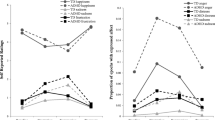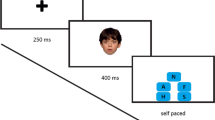Abstract
In contrast to typically developing children, children with autism rarely exhibit cooperative social behavior. To examine whether this problem reflects global developmental delays or autism-specific deficits, the present study compared cooperation, emotional understanding, personality characteristics, and social behavior of 10 children with autism who had average IQ to those of 16 children with Attention-Deficit/Hyperactivity Disorder (ADHD) and Oppositional Defiant Disorder (ODD) and 10 typically developing children. In cooperative behavior, level of emotional understanding, and aloof behavior, the autism group outperformed the ADHD/ODD group and did not differ significantly from typically developing children. However, the autism group showed worse emotion recognition and more active-but-odd behavior than the other groups. The results indicate that high-functioning children with autism can develop cooperative social behavior and advanced theory of mind abilities, but continue to show deficits in identifying emotions and displaying socially appropriate behavior.
Similar content being viewed by others
References
S. Baron-Cohen (1991) ArticleTitleDo people with autism understand what causes emotion? Child Development 62 385–395
S. Baron-Cohen (1995) Mindblindness. MIT Press Cambridge, MA
J. Boucher V. Lewis (1992) ArticleTitleUnfamiliar face recognition in relatively able autistic children Journal of Child Psychology and Psychiatry and Allied Disciplines 33 IssueID5 843–859
J.K. Buitelaar M. Wees Particlevan der H. Swaab-Barneveld R.J. Gaag Particlevan der (1999) ArticleTitleTheory of mind and emotion-recognition functioning in autistic spectrum disorders and in psychiatric control and normal children Developmental Psychopathology 11 IssueID1 39–58
E. B. Cadesky V. L. Mota R. J. Schachar (2000) ArticleTitleHow do children with ADHD and/or conduct problems process nonverbal information about affect? American Academy of Child and Adolescent Psychiatry 39 IssueID9 1160–1167
L. Capps N. Yirmiya M. Sigman (1992) ArticleTitleUnderstanding of simple and complex emotions in non-retarded children with autism Journal of Child Psychology and Psychiatry 33 IssueID7 1169–1182
G. Carlo G. P. Knight N. Eisenberg K. J. Rotenberg (1991) ArticleTitleCognitive processes and prosocial behaviors among children: The role of affective attributions and reconciliations Developmental Psychology 27 IssueID3 456–461
P. Castelloe G. Dawson (1991) ArticleTitleSubclassification of children with autism and pervasive developmental disorder: A questionnaire based on Wing’s subgrouping scheme Journal of Autism and Developmental Disorders 23 IssueID2 229–241
M. Chandler (1973) ArticleTitleEgocentrism and anti-social behavior: The assessment and training of social perspective-taking skills Developmental Psychology 9 326–332
D. J. Cohen F. R. Volkmar (1997) Handbook of autism and pervasive developmental disorders Wiley New York
N. R. Crick K. A. Dodge (1994) ArticleTitleA review and reformulation of social information-processing mechanisms in children’s social adjustment Psychological Bulletin 115 IssueID1 74–101
K. A. Dodge (1986) A social information processing model of social competence in children M. Perlmutter (Eds) Minnesota symposia on child psychology Erlbaum Hillsdale, NJ 77–125
K. A. Dodge (1989) Problems in social relationships E. J. Marsh R. A. Barkley (Eds) Treatment of childhood disorders Guilford Press New York 222–244
J. B. Grossman A. Klin A. S. Carter F. R. Volkmar (2000) ArticleTitleVerbal bias in recognition of facial emotions in children with Asperger syndrome Journal of Child Psychology and Psychiatry and Allied Disciplines 41 IssueID3 369–379
M. Hauck D. Fein N. Maltby L. Waterhouse C. Feinstein (1998) ArticleTitleMemory for faces in children with autism Child Neuropsychology 4 187–198
B. Hermelin N. O’Connor (1985) The logico-affective disorder in autism E. Schopler G.B. Mesibov (Eds) Communication problems in autism Plenum Press New York 283–310
R. P. Hobson (1986) ArticleTitleThe autistic child’s concept of people Communication 20 12–17
R. P. Hobson J. Ouston A. Lee (1988) ArticleTitleWhat’s in a face? The case of autism British Journal of Psychology 79 441–453
R. P. Hobson J. Ouston A. Lee (1989) ArticleTitleNaming emotion in faces and voices: Abilities and disabilities in autism and mental retardation British Journal of Developmental Psychology 7 237–250
S. Holroyd S. Baron-Cohen (1993) ArticleTitleBrief report: How far can people with autism go in developing a theory of mind? Journal of Autism and Developmental Disorders 23 379–385
P. Howlin S. Baron-Cohen J. Hadwin (1999) Teaching children with autism to mind-read: A practical guide Wiley West Sussex
A. Klin W. Jones R. Schultz F. Volkmar D. Cohen (2002) ArticleTitleVisual fixation patterns during viewing of naturalistic social situations as predictors of social competence in individuals with autism Archives of General Psychiatry 59 IssueID9 809–816
G. P. Knight (1981) ArticleTitleBehavioral and sociometric methods of identifying cooperators, competitors, and individualists: Support for the validity of the social orientation construct Developmental Psychology 17 IssueID4 430–433
G. P. Knight S. Kagan (1977) ArticleTitleDevelopment of prosocial and competitive behaviors in Anglo-American and Mexican-American children Child Development 48 1385–1394
F. W. Kohler P. S. Strain (1990) ArticleTitlePeer-assisted interventions: Early promises, notable achievements, and future aspirations Clinical Psychology Review 10 441–452
F. W. Kohler P. S. Strain M. Hoyson B. Jamieson (1997) ArticleTitleMerging naturalistic teaching and peer-based strategies to address the IEP objectives of preschoolers with autism: An examination of structural and behavior outcomes Focus on Autism and Other Developmental Disabilities 12 IssueID4 196–206
T. Langdell (1978) ArticleTitleRecognition of faces: An approach to the study of autism Journal of Child Psychology and Psychiatry and Allied Disciplines 19 255–268
D. Lefebvre P. S. Strain (1989) ArticleTitleEffects of a group contingency on the frequency of social interactions among autistic and nonhandicapped preschool children: Making LRE efficacious Journal of Early Intervention 13 IssueID4 329–341
O. I. Lovaas A. B. Ackerman D. Alexander P. Firestone J. Perkins D. Young (1981) Teaching developmentally disabled children: The ME book. Pro-Ed Austin, TX
O.I. Lovaas R. L. Koegel L. Schreibman (1979) ArticleTitleStimulus overselectivity in autism: A review of research Psychology Bulletin 86 IssueID6 1236–1254
D. Matsumoto N. Haan G. Yabrove P. Theodorou C. C. Carney (1986) ArticleTitlePreschoolers’ moral actions and emotions in prisoner’s dilemma Developmental Psychology 22 IssueID5 663–670
C. G. McClintock J. M. Moskowitz (1976) ArticleTitleChildren’s preferences for individualistic, cooperative, and competitive outcomes Journal of Personality and Social Psychology 34 IssueID4 543–555
L. Mottron J. Burack J. Stauder P. Robaey (1999) ArticleTitlePerceptual processing among high-functioning persons with autism Journal of Child Psychology and Psychiatry and Allied Disciplines 40 203–211
M. Prior B. Dahlstrom T. Squires (1990) ArticleTitleAutistic children’s knowledge of thinking and feeling states in other people Journal of Child Psychology and Psychiatry 31 IssueID4 587–601
K. H. Rubin L. Rose-Krasnor (1992) Interpersonal problem-solving and social competence in children V. B. Hasselt Particlevan M. Hersen (Eds) Handbook of social development: A lifespan perspective Plenum Press New York 283–324
M. R. Rutter C. Lord A. Couteur ParticleLe (1994) Autism diagnostic interview MRC Psychiatry Unit, Institute of Psychiatry London
R.T. Schultz I. Gauthier A. Klin R.K. Fullbright A.W. Anderson F. Volkmar P. Skuldarski C. Lacadie D.J. Cohen J.C. Gore (2000) ArticleTitleAbnormal ventral temporal cortical activity during face discrimination among individuals with autism and Asperger syndrome Archives of General Psychiatry 57 IssueID4 331–340
T. Smith (1999) ArticleTitleOutcome of early intervention for children with autism Clinical Psychology: Research and Practice 6 33–49
R. Sparrevohn P. Howie (1995) ArticleTitleTheory of mind in children with autistic disorder: Evidence of developmental progression and the role of verbal ability Journal of Child Psychology and Psychiatry and Allied Disciplines 36 249–263
P. S. Strain (1984) ArticleTitleSocial behavior patterns of nonhandicapped and developmentally disabled friend pairs in mainstream preschools Analysis and Intervention in Developmental Disabilities 4 IssueID1 15–28
D. Tantum L. Monaghan H. Nicholson J. Stirling (1989) ArticleTitleAutistic children’s ability to interpret faces: A research note Journal of Child Psychology and Psychiatry and Allied Disciplines 30 IssueID4 623–630
D. Wechsler (1989) Wechsler Preschool and Primary Scales of Intelligence Psychological Corporation San Antonio
D. Wechsler (1991) Manual for the Wechsler Intelligence Scale for Children-third edition (WISC-III) Psychological Corporation New York
Author information
Authors and Affiliations
Corresponding author
Rights and permissions
About this article
Cite this article
Downs, A., Smith, T. Emotional Understanding, Cooperation, and Social Behavior in High-Functioning Children with Autism. J Autism Dev Disord 34, 625–635 (2004). https://doi.org/10.1007/s10803-004-5284-0
Issue Date:
DOI: https://doi.org/10.1007/s10803-004-5284-0




